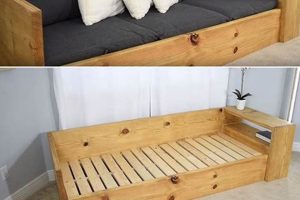A do-it-yourself sleeping platform constructed from reclaimed wooden shipping components offers an alternative to conventional bed frames. These structures repurpose standardized cargo platforms, transforming them into functional and aesthetically unique furniture pieces for residential use. For example, individual platforms can be arranged and secured to create a foundation that supports a mattress.
The increasing interest in constructing bedroom furnishings using repurposed materials reflects a growing awareness of sustainable practices and a desire for personalized home dcor. Utilizing these materials reduces waste and provides an economically viable alternative to commercially manufactured furniture. Historically, the practice of repurposing materials for furniture construction has roots in periods of resource scarcity, but its contemporary resurgence is largely driven by environmental consciousness and creative expression.
The subsequent sections will detail the steps involved in selecting suitable materials, preparing the wooden platforms, assembling the structure, and finishing the resulting bed frame. Considerations for safety, structural integrity, and aesthetic customization will also be addressed.
Constructing a Durable and Safe Sleeping Platform
The following guidelines will enhance the structural integrity and longevity of a sleeping platform made from reclaimed wooden components.
Tip 1: Material Selection: Prioritize heat-treated (HT) components over those treated with methyl bromide (MB), indicated by stamps on the wood. HT signifies a safer, non-toxic treatment method. Avoid platforms exhibiting signs of significant damage, rot, or infestation.
Tip 2: Thorough Cleaning and Preparation: Clean the wooden components using a stiff brush, soap, and water. Allow them to dry completely to prevent mold growth. Sanding smooths rough surfaces and prepares the wood for finishing.
Tip 3: Structural Reinforcement: Add internal supports, such as additional lumber pieces screwed into the existing frame, to bolster the load-bearing capacity of the structure. This is particularly important for larger mattresses or heavier individuals.
Tip 4: Secure Fastening: Utilize screws of appropriate length and gauge, ensuring they penetrate deeply into the wood without protruding. Pre-drilling pilot holes prevents splitting and facilitates easier assembly.
Tip 5: Surface Sealing: Apply a sealant or finish to protect the wood from moisture, stains, and wear. Consider using a low-VOC (volatile organic compound) sealant to minimize off-gassing.
Tip 6: Edge Protection: Address sharp edges and corners by sanding them smooth or applying edge banding to prevent injury. Consider the placement of the frame to minimize accidental contact with protruding edges.
Tip 7: Ventilation Considerations: Ensure adequate airflow beneath the platform to prevent moisture accumulation and promote mattress longevity. Leaving space between the components or incorporating a slatted design facilitates ventilation.
Adhering to these recommendations ensures a robust and secure sleeping platform that maximizes the lifespan of the repurposed materials.
The subsequent section will address aesthetic customization options for this structure.
1. Sourcing
The origin of reclaimed wooden shipping components directly affects the overall quality, safety, and environmental impact of the resulting sleeping platform. Careful material procurement is not merely a preliminary step, but a critical determinant of the final product’s suitability for residential use. The selection process influences the structural integrity, potential health risks, and the ecological footprint of the furniture piece.
For instance, sourcing platforms from reputable businesses that adhere to strict handling and treatment protocols minimizes the risk of exposure to harmful chemicals or biological contaminants. An example is prioritizing suppliers who provide heat-treated (HT) platforms, avoiding those treated with methyl bromide (MB), a known ozone-depleting substance. Furthermore, obtaining platforms from indoor storage facilities reduces the likelihood of weathering, decay, and pest infestation, all of which compromise the wood’s structural soundness. The geographical origin can also impact wood density and durability, making locally sourced, hardwood platforms a potentially superior option.
In conclusion, sourcing represents a fundamental aspect of the DIY project. Neglecting to prioritize the origin and treatment of these materials can result in a structurally unsound, potentially hazardous, and environmentally unsustainable furniture piece. Selecting appropriate materials is therefore paramount for achieving a safe and durable sleeping platform with minimal environmental impact.
2. Preparation
Proper preparation is a fundamental phase in creating a functional and aesthetically pleasing sleeping platform from reclaimed wooden shipping components. This stage significantly influences the structural integrity, longevity, and safety of the final furniture piece. Neglecting adequate preparation can lead to premature wear, instability, and potential hazards for the user.
- Cleaning and Sanitation
Thorough cleaning removes accumulated dirt, debris, and potential contaminants from the wooden components. This involves scrubbing with soap and water, followed by complete drying to prevent mold growth. Example: Failure to remove embedded splinters can result in discomfort or injury. Sanitization addresses potential biological hazards, such as mold spores or insect infestations, ensuring a hygienic sleeping environment.
- Sanding and Smoothing
Sanding eliminates rough edges, splinters, and imperfections on the wood surface, creating a smoother and safer texture. This step prepares the wood for finishing and enhances the overall aesthetic appeal. Example: Untreated rough surfaces can snag bedding or cause skin irritation. Progressive sanding with varying grits achieves a refined surface.
- Structural Assessment and Repair
A comprehensive assessment identifies weakened or damaged areas requiring reinforcement or repair. This may involve replacing damaged boards, reinforcing joints, or adding supplemental supports to enhance the load-bearing capacity. Example: Cracks or splits in the wood compromise structural stability and require immediate attention. Failure to address these issues can lead to structural failure under load.
- Treatment and Sealing
Applying a sealant or finish protects the wood from moisture, stains, and wear, extending its lifespan and maintaining its aesthetic appeal. Consider using low-VOC (volatile organic compound) sealants to minimize off-gassing and promote indoor air quality. Example: Untreated wood is susceptible to water damage and discoloration. Sealing also prevents splintering and simplifies cleaning.
In conclusion, the preparation phase is not merely a preliminary step but a crucial determinant of the finished sleeping platform’s quality and longevity. Thorough cleaning, sanding, structural assessment, and protective treatments ensure a safe, durable, and aesthetically pleasing furniture piece. Effective preparation is essential for maximizing the benefits and minimizing the risks associated with this repurposing project.
3. Assembly
The assembly process represents the pivotal stage in transforming individual wooden platforms into a cohesive and functional sleeping structure. The specific methodology employed directly influences the structural integrity, stability, and overall usability of the bed frame. Improper assembly techniques can compromise the frame’s load-bearing capacity, resulting in instability, premature wear, or even structural failure. For example, inadequate fastening methods or misaligned components can create weak points, particularly under the concentrated weight of a mattress and occupants. The chosen assembly approach must account for the inherent variations in platform dimensions and material properties to ensure a level and secure sleeping surface.
Various assembly techniques can be utilized, ranging from simple stacking and securing with straps to more complex methods involving screwing, bolting, or employing mortise-and-tenon joinery. The selection of an appropriate technique depends on factors such as the desired aesthetic, the skill level of the constructor, and the intended load capacity of the frame. For instance, a basic frame might involve simply arranging the platforms in a rectangular configuration and securing them with heavy-duty straps, a method suitable for lightweight mattresses and temporary use. In contrast, a more robust frame designed for long-term use and heavier loads would necessitate the use of screws and potentially metal brackets to reinforce joints and prevent shifting.
In conclusion, the assembly phase is not merely a matter of connecting individual components but a critical process that determines the structural soundness and overall functionality of the completed wooden platform bed frame. Diligence in selecting appropriate assembly techniques, ensuring precise alignment, and employing secure fastening methods is paramount for creating a safe, durable, and comfortable sleeping surface. Challenges such as variations in component dimensions and the need for specialized tools can be mitigated through careful planning and meticulous execution, ensuring a successful and long-lasting result.
4. Finishing
The “finishing” stage in the construction of a wooden platform bed frame from reclaimed shipping components significantly impacts both the aesthetic appeal and the long-term durability of the structure. This phase encompasses a range of surface treatments applied to the wood after assembly, serving to protect the material from environmental factors, enhance its visual characteristics, and ensure user safety. For example, the application of a sealant or varnish creates a protective barrier against moisture penetration, preventing rot and decay. Similarly, sanding and the application of wood stain can transform the raw, often weathered appearance of the reclaimed wood into a refined and aesthetically pleasing surface. Thus, the finishing stage is a critical determinant of both the functional lifespan and the visual integration of the platform bed frame within a given living space. Failure to properly finish the wooden surfaces can result in premature degradation of the wood, increased risk of splintering, and a less aesthetically appealing final product.
Consider the specific example of a platform frame intended for outdoor use. In such a scenario, a penetrating oil-based finish with UV inhibitors would be essential to protect the wood from moisture, direct sunlight, and temperature fluctuations. Conversely, for an indoor platform frame, a water-based polyurethane finish might be preferred due to its lower VOC emissions and ease of application. The choice of finish also influences the tactile experience of the bed frame. A smooth, polished finish minimizes the risk of snagging bedding or causing skin irritation, while a textured finish can enhance the rustic aesthetic. Practical application further involves considering the compatibility of the chosen finish with the specific type of wood used in the construction of the platform frame, as some finishes may react adversely with certain wood species. Understanding these nuances allows for informed decisions that optimize the durability and aesthetic qualities of the finished product.
In summary, the finishing stage is integral to the successful creation of a wooden platform bed frame. It extends beyond mere aesthetic considerations, encompassing essential protective measures that enhance the structure’s longevity and ensure user safety. By carefully selecting appropriate finishes and applying them meticulously, the builder can transform reclaimed wooden shipping components into a durable, aesthetically pleasing, and environmentally conscious piece of furniture. Challenges related to finish selection and application can be mitigated through research, experimentation, and adherence to best practices, ultimately contributing to a successful and satisfying DIY project.
5. Safety
The integration of safety considerations is paramount in the construction of a sleeping platform from reclaimed wooden shipping components. The inherent nature of repurposed materials presents distinct challenges requiring proactive measures to mitigate potential hazards. Neglecting safety protocols can result in structural failures, exposure to harmful substances, and increased risk of injury.
- Structural Integrity and Load Capacity
The ability of the platform to withstand the combined weight of the mattress and occupants is a primary safety concern. A thorough assessment of the components’ structural integrity is essential. Example: Using damaged or weakened platforms without reinforcement can lead to collapse under load, resulting in injury. Implementing internal supports and secure fastening methods are critical for ensuring adequate load capacity.
- Material Contamination and Treatment
Reclaimed wooden shipping components may have been treated with chemicals or exposed to contaminants during their previous use. Identifying the treatment method and mitigating potential risks is crucial. Example: Platforms treated with methyl bromide (MB) pose a health hazard due to residual fumigant. Selecting heat-treated (HT) platforms and thoroughly cleaning the wood reduces the risk of exposure to harmful substances.
- Surface Hazards and Protrusions
Rough surfaces, sharp edges, and protruding fasteners can cause injury. Addressing these hazards through sanding, edge banding, and countersinking screws is essential. Example: Unaddressed splinters or sharp corners can cause cuts and abrasions. Careful attention to surface finishing minimizes the risk of injury from accidental contact.
- Fire Resistance and Flammability
Untreated wood is inherently flammable, posing a fire hazard. Applying a fire-retardant coating can reduce the risk of fire spread in the event of a fire. Example: An exposed flame source, such as a candle or faulty electrical wiring, can ignite untreated wood, leading to a rapid fire. Selecting fire-resistant materials and applying appropriate coatings enhances the safety of the structure.
These safety facets underscore the importance of informed decision-making and meticulous execution throughout the project. By prioritizing structural integrity, addressing potential contamination, mitigating surface hazards, and considering fire resistance, individuals can significantly reduce the risks associated with the utilization of reclaimed wooden shipping components in residential furniture construction. The implementation of these safety measures is crucial for creating a secure and healthy sleeping environment.
Frequently Asked Questions
This section addresses common inquiries regarding the construction of sleeping platforms utilizing reclaimed wooden shipping components. The information presented aims to provide clarity and guidance on various aspects of the process.
Question 1: Are all reclaimed wooden shipping components suitable for constructing a bed frame?
No. Components exhibiting signs of significant damage, rot, or infestation should be avoided. The presence of certain stamps indicates treatment with potentially harmful chemicals, rendering them unsuitable for residential use. Selection should prioritize heat-treated platforms in sound structural condition.
Question 2: Is it necessary to clean reclaimed wooden components before assembly?
Yes. Thorough cleaning is essential to remove dirt, debris, and potential contaminants accumulated during transport and storage. This process minimizes the risk of exposure to harmful substances and promotes a hygienic sleeping environment.
Question 3: How can the structural integrity of a wooden platform bed frame be enhanced?
Structural integrity can be improved through the addition of internal supports, such as lumber pieces screwed into the existing frame. Secure fastening methods, utilizing screws of appropriate length and gauge, are also crucial. Reinforcing joints with metal brackets provides added stability.
Question 4: What type of finish is recommended for a wooden platform bed frame?
The choice of finish depends on the intended use and desired aesthetic. For indoor applications, a low-VOC polyurethane finish is often preferred due to its durability and minimal off-gassing. For outdoor use, a penetrating oil-based finish with UV inhibitors is recommended.
Question 5: How can the risk of injury from sharp edges and splinters be minimized?
Sharp edges and corners should be sanded smooth or covered with edge banding to prevent accidental injury. Thorough sanding of all surfaces eliminates splinters and creates a safer tactile experience.
Question 6: Is it necessary to provide ventilation beneath a wooden platform bed frame?
Yes. Adequate airflow beneath the platform prevents moisture accumulation and promotes mattress longevity. Leaving space between platforms or incorporating a slatted design facilitates ventilation, reducing the risk of mold growth.
Proper material selection, thorough preparation, secure assembly, and appropriate finishing are critical for constructing a safe and durable wooden platform bed frame. Adhering to these guidelines minimizes risks and ensures a comfortable sleeping environment.
The subsequent section provides a conclusion summarizing the key takeaways from this discussion.
Conclusion
The preceding sections have detailed the key considerations involved in constructing a diy bed frame from pallets. Sourcing appropriate materials, ensuring thorough preparation, employing robust assembly techniques, and applying suitable finishes are essential for a structurally sound and aesthetically pleasing result. Furthermore, prioritizing safety through careful design and construction minimizes potential hazards associated with repurposed materials.
Ultimately, the successful realization of a diy bed frame from pallets hinges upon a commitment to informed decision-making and meticulous execution. While offering a cost-effective and environmentally conscious alternative to conventional furniture, the undertaking requires careful planning and diligent effort to ensure both its longevity and its suitability for residential use. The pursuit of this project embodies a broader trend toward sustainable practices and personalized home design.







